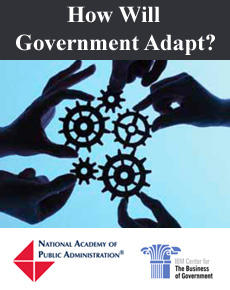
How Will Government Adapt?: Shifting Defense Priorities and Fiscal Realities

In particular, the Department must focus on mitigating high-risk issues and inefficiencies, including data security and accessibility, base realignment, and cost of employee benefits. The Department has already made progress in employing a change management approach, but further effort is needed. In light of these challenges, the Department can seize the current opportunity to maximize its resources and cultivate more strategic enterprise-level leadership. This is the third blog post in a series that sums up highlights of selected sessions held as part of the annual meeting in mid-November of the National Academy of Pubic Administration. Panel Members: William R. Phillips, Charter Member, U. S Department of Defense Business Board; Principal-in-Charge, KPMG Federal Advisory The Honorable Robert F. Hale, Former Under Secretary (Comptroller) and Chief Financial Officer, Office of the Under Secretary of Defense, U.S. Department of Defense William C. Greenwalt, Fellow, American Enterprise Institute The Honorable Elizabeth A. McGrath, Former Deputy Chief Management Office, U.S. Department of Defense; Director, Federal Government and Commercial Clients, Deloitte Consulting LLP Highlights DoD traditionally receives high marks for its mission accomplishments. It is viewed as a model for addressing international crises and executing the jobs that it is asked to execute. The Department has made significant headway in terms of focusing on cost-cutting initiatives. They have taken efforts to tackle many of its GAO-designated high-risk areas, as well. In the past, many of the cost-cutting decisions were made locally at the installation-level. The local-level cost-cutting strategy did not allow a focus on opportunities for inter-operability and cost savings at the enterprise-level. The current fiscal environment of long-term austerity and uncertainty regarding the continuation of the sequester has become a compelling reason for action. In the past, the incentive to change was minimized because there were sufficient resources. However, because of the lack of money for the foreseeable future, Defense agencies are increasingly considering use of a shared service model. In situations where there is a trust-based relationship among key stakeholders, they are more inclined to think of how this could be implemented. Defense agencies are just barely tapping into this kind of arrangement, and there are service providers throughout the Department that should have an enterprise-wide customer service perspective. It is a big shift in how Defense agencies think, and it is not one that is easily done. DoD is hamstrung by the “best practices of the past,” which are often codified in legislation. Despite being one of the best-managed departments of the federal government, there has not been a real compelling reason to change due to its robust budget. The last time in which there was a compelling reason to change was in the cutbacks that occurred the post-Cold War era. The Department’s congressional oversight community has changed in the last decade, and they are not necessarily looking for best practices; they are looking for savings. However, declining budgets may actually open up the need to look into current-day best practices and ways to improve mission effectiveness. The Department’s current management structure may have been good for the past war efforts, but it is not necessarily appropriate for the information age. According to Defense Business Board studies, 40 percent of DoD’s budget is considered to be “overhead.” To make changes in the ratio between overhead and mission delivery spending, you have to get specific, and you have to have an agenda. Since this is substantial amount of money, you have to be able to give specifics to Congress with which they must agree. Historically, Congress has been very supportive and helpful to the Department, but continued goodwill depends on working relationships between the leadership on the Hill and in the Department. A shift in congressional oversight seemed to occur during the Iraq War, and bipartisan consensus seemed to dissolve as that campaign has concluded. Moving forward, there is now an opportunity for the Department to re-engage with all of its stakeholders to improve management and operations. To this end, persistence is important. Congress has a need to understand what the Department needs, and Congress will listen if the Secretary or senior officials ask. (Prepared by Daniel Orr, NAPA) Visit the landing page of this initiative where you can learn of future blog post topics and follow previous conversations.



